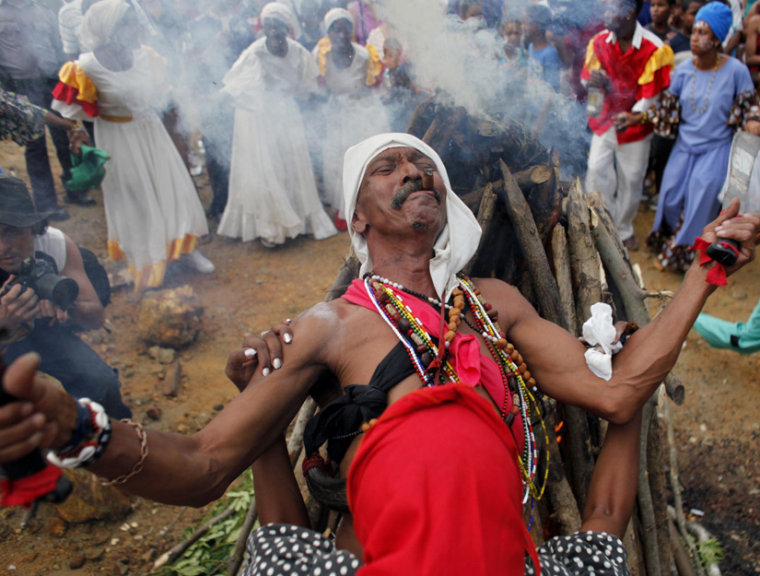Tis the season of the dead: from Halloween to All Saint's Day, when traditionally Christian societies venerate those who have passed on. But for practitioners of the Afro-Cuban philosophy of Santería, the line between the dead and living knows no season; it's almost always a shadowy one.
Afro-Cuban emigre Philbert Armenteros, founder of the Miami band Los Herederos (The Inheritors), says his music can channel important messages from the gods of his African ancestors.
"It puts (listeners) in a different dimension, one that allows them to experience cleansing, purity and inner peace," Armenteros told Discovery News.
Armenteros literally means a different dimension. When he drums and chants in a certain sequence, some of his listeners are lulled into a trance.
Those who practice Santería say the trance opens the doors to spirit possession, and the gods, or orishas, briefly enter the trance-induced body and use it for earthly advising.
"It does happen at concerts, but the full effect is more likely when all the right elements are present in a ceremony," said Armenteros, explaining that more authentic trance experiences would include all the tools, such as a spiritual leader, i.e. a babalawo, or a Santero, and offerings.
Santería, also called Regla de Ocha, is a slimmed-down system of beliefs that came from the Yoruba people, in what is now Nigeria.
It is considered one of the most African of all Afro-American religious blends. Other popular examples include Haitian Vodou and Brazilian Candomblé. Each evolved within the confines of slavery in French, Spanish and Portuguese colonies.
Forced to convert to Catholicism. slaves soon noticed that many Catholic saints resembled their own ancestral gods. For example, Santería, Vodou, and Candomble all associate Saint Barbara, the patron saint of artillery, with Chango or Shango, the god of thunder. Today, tens of thousands of people practice these blends.
INVESTIGATION DISCOVERY: Play the Haunting Game
Social scientists say that trances, a behavior common to all kinds of world religions, is biological, but also caused by learned behavior.
According to Dr. Peter Naish, a senior lecturer in cognitive psychology at the Open University in the U.K., asymmetrical brains — those whose two hemispheres process information at disproportionate speeds — are more capable of playing the hallucinatory tricks indicative of hypnosis and trance.
In his study "Hypnosis and Hemispheric Asymmetry," published in the Jan. 2010 edition of the journal Consciousness and Cognition, he noted higher hypnotic susceptibility in those who, before being hypnotized, processed information much more quickly in the left brain hemisphere than the right. But during hypnosis, the situation flipped and the right became faster. No one knows whether they are born with that wiring or if it comes through experience.
"Clearly, highly hypnotizable brains are different," said Naish, "but what you do once you are hypnotized is largely down to expectation. If you have the assumption that you visit the spirit world and can’t remember what you did there, then I dare say that’s what you do."
Erika Bourguignon, a leading expert on Afro-Caribbean spirit possession and professor emerita at Ohio State University, says that altered state is characterized in Afro-Caribbean religions by shaking, staring and the absence of facial expression.
"We know altered states are general human capacities. There are dreams, and dreams are a kind of altered state," Bourguinon said.
All this scientific discussion is fine with the Santería practitioners because not everybody should fall into a trance, noted Cuban anthropologist and television producer Fermin Fleites.
"Those who don't are sometimes chosen as babalawos," he said, explaining that these spiritual leaders help to interpret what a trance-induced person won't remember saying.
For Joseph M. Murphy, a theology professor at Georgetown University in Washington, D.C., these elements are all part of the community spirit of the practice.
"It's quite lovely to see how people form a protective ring around the person to settle the spirit. The person won’t look like themselves and they'll talk with a lot of authority and presence of the spirit that takes them," Murphy said.
Both followers of Santería and social scientists insist that none of the manifestations of African spirituality are as macabre as the media has often portrayed.
Murphy says the stereotypes probably stem from Vodou ceremonies that preceded the 1791 Haitian Revolution to overthrow the French. "It scared the living daylights out of slave holders in the West," he said.
It's true that practitioners of Santería, Vodou, Candomblé, and a few other similar Afro-American religions perform animal sacrifices and cast spells, but all are advised not to do anything that could have negative repercussions.
"All these religions involve a moral code, an idea of what the spirits will punish. But there's also the concept of the good life, a respect for authority, elders, and tradition," said Bourguinon.
Protection from evil is also part of the faith, explained Renee Chavez, a Miami-based Santería practitioner and choreographer of Afro-Indigenous dance.
"Unless you allow something, it cannot happen. That's why the trance is one of the most important aspects of Santería," she said, explaining that if you're biologically prone to having a trance, you and your community are in for quite an experience. "You're allowing yourself to be enraptured by the song and the music, which allows you to be your most high self ... a vessel for getting messages to other people."
